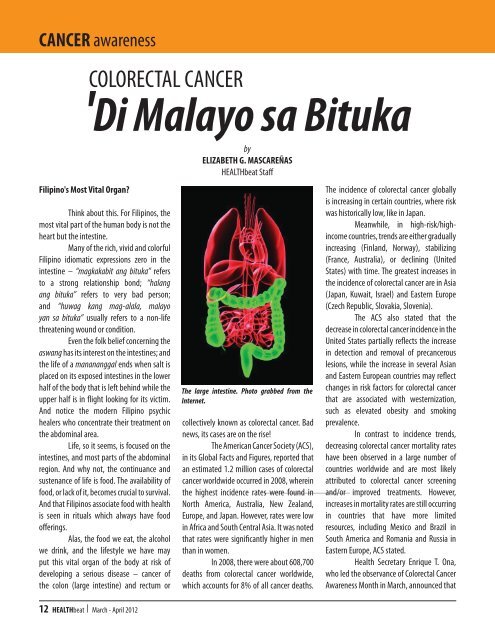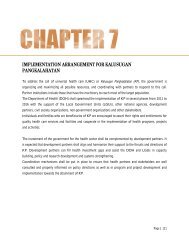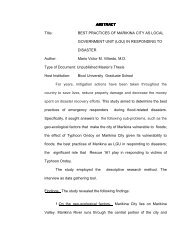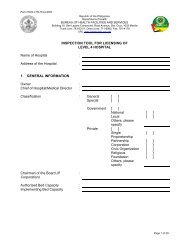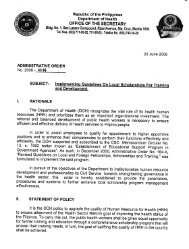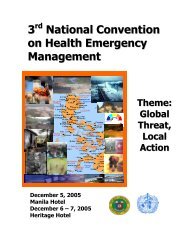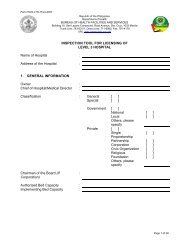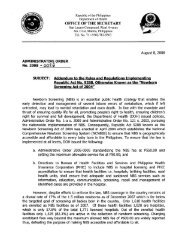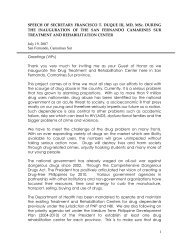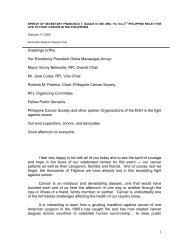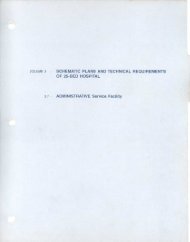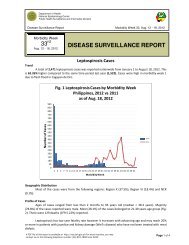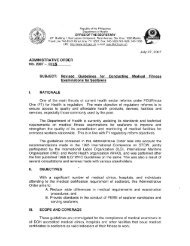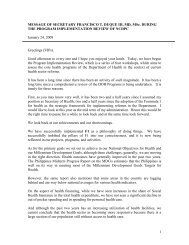Issue No. 69 - March - April 2012 - DOH
Issue No. 69 - March - April 2012 - DOH
Issue No. 69 - March - April 2012 - DOH
- No tags were found...
You also want an ePaper? Increase the reach of your titles
YUMPU automatically turns print PDFs into web optimized ePapers that Google loves.
CANCER awarenessCOLORECTAL CANCER'Di Malayo sa BitukaFilipino's Most Vital Organ?Think about this. For Filipinos, themost vital part of the human body is not theheart but the intestine.Many of the rich, vivid and colorfulFilipino idiomatic expressions zero in theintestine – “magkakabit ang bituka” refersto a strong relationship bond; “halangang bituka” refers to very bad person;and “huwag kang mag-alala, malayoyan sa bituka” usually refers to a non-lifethreatening wound or condition.Even the folk belief concerning theaswang has its interest on the intestines; andthe life of a manananggal ends when salt isplaced on its exposed intestines in the lowerhalf of the body that is left behind while theupper half is in flight looking for its victim.And notice the modern Filipino psychichealers who concentrate their treatment onthe abdominal area.Life, so it seems, is focused on theintestines, and most parts of the abdominalregion. And why not, the continuance andsustenance of life is food. The availability offood, or lack of it, becomes crucial to survival.And that Filipinos associate food with healthis seen in rituals which always have foodofferings.Alas, the food we eat, the alcoholwe drink, and the lifestyle we have mayput this vital organ of the body at risk ofdeveloping a serious disease – cancer ofthe colon (large intestine) and rectum orbyELIZABETH G. MASCAREÑASHEALTHbeat StaffThe large intestine. Photo grabbed from theInternet.collectively known as colorectal cancer. Badnews, its cases are on the rise!The American Cancer Society (ACS),in its Global Facts and Figures, reported thatan estimated 1.2 million cases of colorectalcancer worldwide occurred in 2008, whereinthe highest incidence rates were found in<strong>No</strong>rth America, Australia, New Zealand,Europe, and Japan. However, rates were lowin Africa and South Central Asia. It was notedthat rates were significantly higher in menthan in women.In 2008, there were about 608,700deaths from colorectal cancer worldwide,which accounts for 8% of all cancer deaths.The incidence of colorectal cancer globallyis increasing in certain countries, where riskwas historically low, like in Japan.Meanwhile, in high-risk/highincomecountries, trends are either graduallyincreasing (Finland, <strong>No</strong>rway), stabilizing(France, Australia), or declining (UnitedStates) with time. The greatest increases inthe incidence of colorectal cancer are in Asia(Japan, Kuwait, Israel) and Eastern Europe(Czech Republic, Slovakia, Slovenia).The ACS also stated that thedecrease in colorectal cancer incidence in theUnited States partially reflects the increasein detection and removal of precancerouslesions, while the increase in several Asianand Eastern European countries may reflectchanges in risk factors for colorectal cancerthat are associated with westernization,such as elevated obesity and smokingprevalence.In contrast to incidence trends,decreasing colorectal cancer mortality rateshave been observed in a large number ofcountries worldwide and are most likelyattributed to colorectal cancer screeningand/or improved treatments. However,increases in mortality rates are still occurringin countries that have more limitedresources, including Mexico and Brazil inSouth America and Romania and Russia inEastern Europe, ACS stated.Health Secretary Enrique T. Ona,who led the observance of Colorectal CancerAwareness Month in <strong>March</strong>, announced that12 HEALTHbeat I <strong>March</strong> - <strong>April</strong> <strong>2012</strong>


